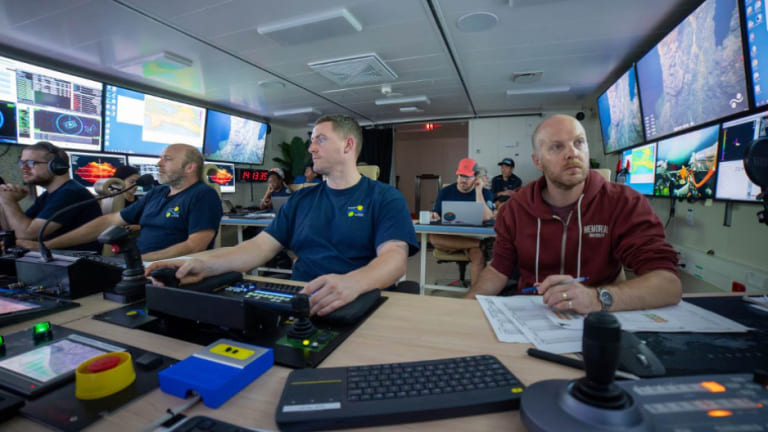
Scientists are utilizing new technology to chart the ocean floor in the Galápagos | Travel News
Although the Earth's surface is predominantly covered by the ocean, our understanding of its geological formations is still restricted. Only a fraction, less than 10 percent, of the ocean floor has been sufficiently charted, leading to lingering uncertainties among scientists regarding Earth's processes and history.
The BEcoME project, supported by the Ocean Frontier Institute (OFI) and led by Dalhousie and Memorial University, seeks to address this gap in understanding. The project's primary goal is to gain a better understanding of the role played by benthic habitats in the face of a changing ocean climate.
In order to comprehend these ecosystems on the ocean floor, scientists are employing innovative technologies to create maps of their physical features. This mapping process is crucial for unraveling the mysteries of the ocean and advancing our knowledge of its complex ecosystems.
Charting the Ocean Floor in the Galápagos
In a quest to enhance our understanding of the Pacific Ocean's distinctive region, a group of marine scientists supported by the Ocean Frontier Institute (OFI) embarked on a research expedition to the Galápagos known as Project Zombie. This five-week venture, also backed by the Schmidt Ocean Institute (SOI), aimed to gather data supporting the BEcoME project, employing cutting-edge seafloor mapping technologies.
The research vessel Falkor (too) accommodated 24 scientists from various parts of the world, spearheaded by Chief Scientist Dr. John Jamieson from Memorial University. The team included BEcoME project co-lead Dr. Craig Brown from Dalhousie, along with PhD candidates Caroline Gini (MUN) and Jake Tan (Dalhousie).
The primary objective was to assess the capabilities of a novel imaging technology called Interferometric Synthetic Aperture Sonar (SAS), developed by Kraken Robotics based in Newfoundland. This seafloor mapping technology has the capacity to generate high-resolution acoustic images and bathymetric maps of the ocean floor. Although already utilized in defense and offshore energy applications, its scientific applications had not been previously tested.
Dr. Craig expressed, “The OFI BEcoME project is pushing the boundaries of research by exploring and testing the application of some new mapping technologies. This SOI cruise was an exciting opportunity to install the latest mapping systems on a state-of-the-art deep-water submersible and really put them through their paces in a deep water environment.” He added, “These areas had never been mapped before, and in addition to testing the technologies, the data led to the discovery of new hydrothermal vent systems.”

Exploring Underwater Marvels
"The success and efficiency demonstrated by this project in high-resolution mapping and imaging for seafloor exploration, discovery, and classification validate the importance of developing and testing new technology for understanding the benthic environment," remarked Dr. Jamieson.
Utilizing the precision of InSAS technology, Dr. Jamieson and his team returned with numerous new and remarkable findings. The research expedition focused on three hydrothermal vent fields north of the Galapagos Islands, unveiling a newly discovered field named "Tortugas" through the high-resolution mapping technology. This name was chosen in homage to the renowned turtles commonly found in the surrounding waters of the islands.
Hydrothermal vents, often associated with submarine volcanoes along oceanic tectonic plate boundaries, result from the circulation of seawater through the crust, creating hot springs at the seafloor. These environments support unique underwater life forms adapted to the extreme conditions. Additionally, hydrothermal vents are known for their richness in valuable metals. The expedition scientists are now delving into understanding the formation and resource potential of these mineral deposits, along with assessing the environmental risks associated with potential exploitation.
The expedition brought forth other significant discoveries, including the identification of a Pacific white skate nursery, a rarity with only two documented globally. Moreover, the researchers uncovered 15 species of sea floor animals previously unknown to the area, some of which may potentially be entirely new to science.
3D Mapping of Deep-Water Coral Reefs

Dr. Katleen Robert, co-lead of the BEcoME project at Memorial University's Marine Institute, spearheaded a separate expedition on the Falkor (too) in the Galápagos preceding Dr. Jamieson's cruise, also dedicated to collecting data for the BEcoME project.
Dr. Robert and her team focused on another goal of the BEcoME project—mapping deep-water coral habitats in 3D. The Galápagos Islands house deep-water cliff-dwelling coral reefs that have been minimally impacted by human activities and exist under diverse environmental conditions. Enhancing our understanding of cold-water corals globally is crucial for predicting the potential changes in deep-water coral reefs in the near future. Dr. Robert's team utilized the state-of-the-art Voyis Insight Micro laser scanner to create ultra-high resolution point-cloud reconstructions of these reefs—a feat previously challenging due to inadequate technologies.
The expedition employed SuBastian, a cutting-edge remotely-operated vehicle (ROV) designed specifically for the deep sea, capable of reaching depths of up to four-thousand-five-hundred meters. The ROV was equipped with a laser system to collect data on reefs found at approximately 350 meters depth. This dataset will allow for the investigation of fine-scale relationships between habitat complexity and the organisms inhabiting these areas. Dr. Katleen Robert's expedition achieved significant success, discovering two thriving deep-sea reefs, with the larger one spanning eight hundred meters in length.
"We are thrilled that our mapping data can enhance our understanding of reef ecosystems in the Galápagos," remarked Dr. Robert. "The interdisciplinary science team is excited that the data collected during this expedition will contribute to growing knowledge on the Galápagos National Marine Reserve and contribute to the management of the Eastern Tropical Pacific Marine Corridor."
The BEcoME project remains committed to advancing the collective understanding of the ocean floor through mapping, contributing to the groundwork for future sustainable ocean stewardship.

